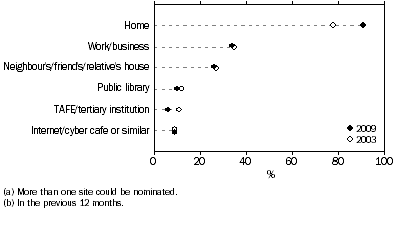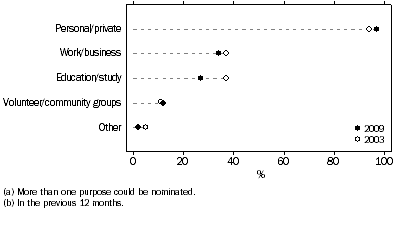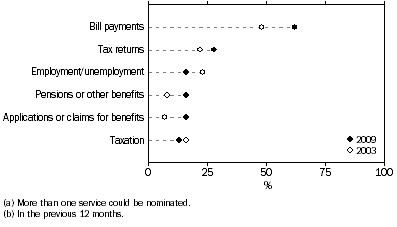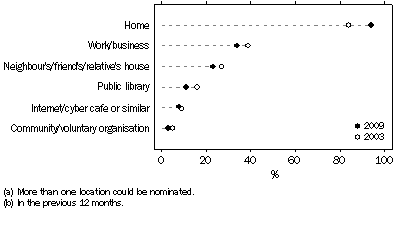Contents >>
INTERNET AND COMPUTER USE BY PERSONS WITH A DISABILITY
INTERNET AND COMPUTER USE BY PERSONS WITH A DISABILITY
The statistics presented in this section were collected in the 2003 and 2009 Surveys of Disability, Ageing and Carers (SDAC). The figures relate to people aged 15 years and over with a reported disability who live in private dwellings, excluding those who reported only having a disfigurement or deformity without any limitations. For the purposes of SDAC, disability is defined as any limitation, restriction or impairment which restricts everyday activities and has lasted or is likely to last for at least six months.
These data have previously been released in Disability, Ageing and Carers, Australia: Summary of Findings (cat. no. 4430.0).
INTERNET USE BY PERSONS WITH A DISABILITY
In 2009, more than three in five (62%) of persons with a reported disability had internet access at home, compared to just over two in five (41%) in 2003.
Just over half (53%) of persons with a reported disability used the internet at any location in 2009, up from 39% in 2003.
Activities performed using the internet
Persons with a reported disability who used the internet in the previous 12 months were asked to indicate the activities they performed on the internet, where they used it and their purpose for home internet use.
The most common activities performed using the internet were General browsing (90%) and Use email/access chat sites (83%). More than half of persons with a reported disability used the internet for Accessing government services (51%).
Persons with a reported disability, by selected activities(a) performed on the internet(b)

Location of internet use
In 2009, most persons with a reported disability who used the internet in the previous 12 months did so at Home (91%). The next most common location of internet use was Work/business (34%).
Persons with a reported disability, by selected locations(a) of internet use(b)

Purpose for internet use at home
Persons with a reported disability who used the internet at home in the previous 12 months were asked to indicate their purpose for using the internet. In 2009, the most commonly reported purpose was Personal/private (97%). Work/business and Education/study were the next most common purposes, at 34% and 27% respectively.
Persons with a reported disability, by purpose(a) for internet use at home(b)

Government services accessed on the internet
Of the persons with a reported disability who accessed a government service on the internet for private purposes, almost two thirds (62%) Paid bills electronically. This was more than double the proportion of any other service used, with the next most common service being the electronic lodgement of Tax returns (28%).
Persons with a reported disability, by type of government service(a) accessed on the internet(b)

COMPUTER USE BY PERSONS WITH A DISABILITY
In 2009, 71% of persons with a reported disability had access to a computer at home compared to 55% in 2003.
Just under three in five (57%) persons with a reported disability in 2009 used a computer at any location in the previous 12 months, up from 48% in 2003.
Location of computer use
The majority of persons with a reported disability who used a computer in the previous 12 months, used a computer at Home (94%). The next most common location for computer use was Work/business (34%).
Persons with a reported disability, by selected locations(a) of computer use(b)

 Print Page
Print Page
 Print All
Print All